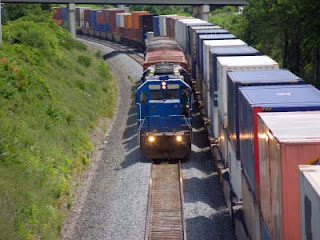1)
Definition of Intermodalism
i)
Not mode of transport
ii)
A system of coordinating different
modes of transport for a shipment
2)
Containerization
i)
ISO 9000 standard ; Set by
organization
ii)
Known as Cargo Container in
Logistics World
iii)
Unitization: Cargo is in the
same size and dimension
3)
Most common modes of
transportation using intermodal
i)
Trucking
ii)
Railroad
iii)
Ocean Shipping
4)
Benefit using intermodal
i)
Security
(a) cargo in container, so hard to get into
(b)
Container identified by serial
number
(c)
Sealed
 |
| Sealed container |
ii)
Safety
(a)
Container cargo safer than any
other types of container
(b)
Strong and almost impossible to
crush
(c)
Weather resistant
iii)
Efficiency
(a)
Container in standard dimension
and specialized equipment design to handle it
 |
| Equipment to handle the container |
(b)
Container is same, no time is
wasted to make adjustment
iv)
Speed
(a)
Closely related to the
Efficiency
(b)
If cargo handle quicker, more
cargo can move through one port in a given amount of time
5)
Standardized of intermodal
equipment
i)
Basic element: Cargo container
ii)
8 feet wide, 8 feet 6 inch
high, length is varies
iii)
Majority used; 20 feet or 40
feet long
iv)
Some; 45 feet, 48 feet
6)
Types of Container
i)
Dry - Basic container and
common used
ii)
Open Top - No top, so cargo can
be laid down into the container, useful for cargo that is awkward to handle
iii)
Flat Rack – No top or sides,
just the bottom and 2 ends. This is also for the awkward cargo
iv)
Platform – There is only the
bottom. Having an awkward piece of cargo on the platform
v)
Refrigerated – Known as a
reefer, built into the container, running on a diesel generator or plugged into
an external power source
vi)
Live animals – designed for
live animal
vii)
Tanker – To carry any liquid
7)
Roadway Transport
i)
Private
(a)
Owned by the shipper
(b)
Eg: Gardenia, Nestle
ii)
Contract
(a)
The shipper does not own them,
but they control & operate them for a specified amount of time.
(b)
Like leased
(c)
Eg: Jusco, Tesco
iii)
Common carrier
(a)
Shipper use the service of
carrier
(b)
Eg: Tiong Nam, Nippon, MAERSK
iv)
Low entry requirement; anyone
can buy truck
v)
Lowest entry cost compared
other modes of transportation
vi)
High competitive market
(involved many players)
vii)
Influence by regulation
(a)
Eg: Speed limit
8)
Railroad Transport
i)
Operation & Ownership can
be either Government OR privatized
ii)
High fixed costs, Low variable
cost
iii)
No weight/volume restriction
but there is restriction on dimension
iv)
High damage and slow
v)
Competition is low
vi)
Shipper use train to move very
large volume goods
vii)
Rail doesn’t have standardized
like truck
9)
Intermodal railroad
i)
Container-on-Flatcar (COFC)
ii)
Trailer-on-Flatcar (TOFC)
10)
Inland shipping
i)
Include rivers, lakes and canal
ii)
Biggest limitation =>
GEOGRAPHY
iii)
Commodity moves; Iron ore, Coal
and Limestone
iv)
Low fixed cost
v)
Competitors: Pipeline &
Railroad
vi)
Types of ship same with ocean
ship but much smaller
11)
Pipeline
i)
High investment, Low variable
cost
ii)
Moves in one direction
iii)
Cargo is safer, low cost and
low risks of damages
iv)
Very dependable & low
maintenance
v)
Not affected by weather
vi)
Slow and limited accessibility

.jpg)






















There's noticeably a bundle to know about this. I assume you made sure nice factors in options also. casino online
ReplyDelete